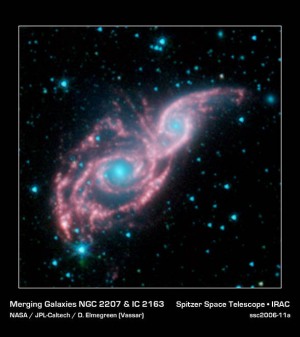Seeing double in galaxy mergers
Posted: July 24, 2011 Filed under: Uncategorized | Tags: agn, galaxy mergers 3 CommentsHow do galaxies grow? One of the most common ways seems to be by merging with other nearby galaxies (a hot research topic that Rita’s talked about in more detail). Seems simple enough, but to really understand how this happens you need to look at a large number of them, at various stages of the merging process.
One way to approach this is by studying active galactic nuclei (AGN) – the extremely bright central regions seen in some galaxies caused by accretion onto their supermassive black holes. Mergers are thought to trigger AGN by funneling cold gas onto the black hole and creating the accretion disc. However, both of the incoming galaxies involved in the merger have their own central black holes, so, if this funelling happens before they themselves merge together, two AGN could be ignited. If you could find systems like this, ideally with a range of separations, what you’ll actually have is a snapshot of many different merging stages. Plus, since AGN only live for a short time, you’ll also be able to get a handle on how long all this takes.
Hundreds of these dual-AGN systems have been detected, but only a small proportion contain AGN that are closer together than 10 kiloparsecs, meaning that we’re missing information on the final stages of the merging process. The situation improved recently with the publication of a paper reporting a pair that are separated by only 4.8 kiloparsecs. One source isn’t enough though to draw conclusions about mergers in general of course, but finding one should make it easier to find more. When it comes to AGN, sometimes two are better than one.
![]() R.C. McGurk, C.E. Max, D.J. Rosario, G.A. Shields, K.L. Smith, S.A. Wright (2011). Spatially-Resolved Spectroscopy of SDSS J0952+2552: a confirmed Dual AGN Submitted to ApJL DOI: arXiv:1107.2651
R.C. McGurk, C.E. Max, D.J. Rosario, G.A. Shields, K.L. Smith, S.A. Wright (2011). Spatially-Resolved Spectroscopy of SDSS J0952+2552: a confirmed Dual AGN Submitted to ApJL DOI: arXiv:1107.2651



If only a few are closer than 10kpc, it seems to suggest that the black holes merge quite quickly – from this point, or one or both is often in an off state.
[…] Galaxies are thought to grow through mergers. This post is about how studying active galaxies can help us to understand this process. […]
Excellent post. When galaxies collide! On a related note, have you seen the latest reserach on SDSS J0952+2552 by McGurk, R.C. et al. (2011)??
I’ve written a little bit about this here: